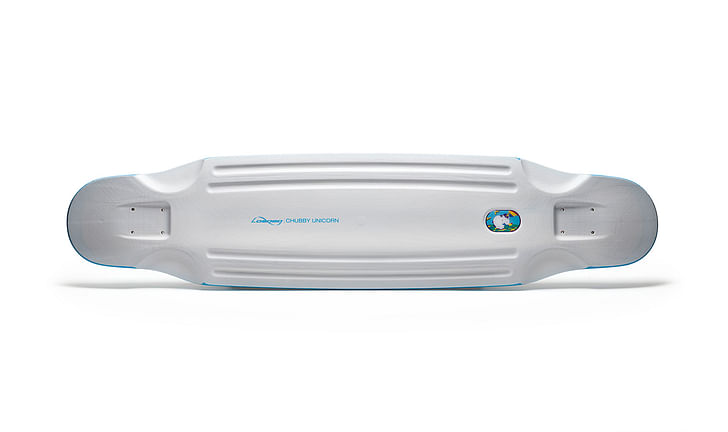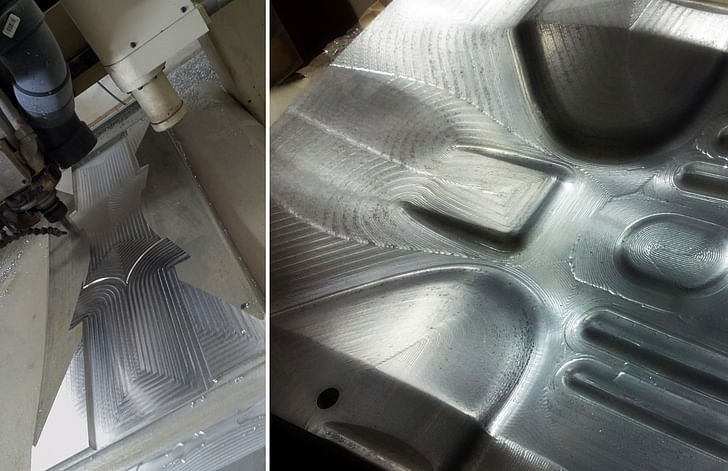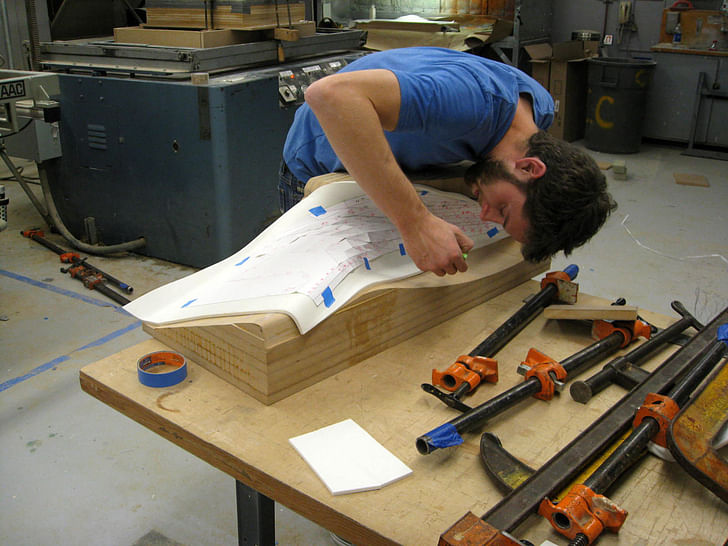

Working out of the Box is a series of features presenting architects who have applied their architecture backgrounds to alternative career paths.
In this installment, we're talking with Daniel Carper, Product Designer at Loaded Boards and Orangatang Wheels.
Are you an architect working out of the box? Do you know of someone that has changed careers and has an interesting story to share? If you would like to suggest an (ex-)architect, please send us a message.
After becoming disillusioned by the architecture profession’s formalities and exclusivity, Daniel Carper brought his skills designing precise and artisanal objects to the world of skateboarding. After working under Greg Lynn and being inspired by the free-mingling of industries, Carper now makes skateboards for Loaded Boards and Orangatang Wheels in Culver City, California, designing and building the one-to-one scale objects he loves using himself.

Where did you study architecture?
Ohio State University – Bachelor of Science in Architecture, class of 2004.
University of California Los Angeles – Master of Architecture, class of 2009.
At what point in your life did you decide to pursue architecture?
As long as I can remember. My grandfather was a furniture builder in Pennsylvania, mostly Early American pieces and toys. I was terrified of his shop and the ominous machinery, but naïve enough to entertain my interest in the process. For him, it was an oasis of creativity and craft. To this day, he’s still the most humble person I’ve known, but he had extreme pride in craftsmanship and the act of making. From these experiences, building stupid boxes and torturous bird houses, I realized that I wanted to pursue design and building things.


When did you decide to stop pursuing architecture? Why?
It was a series of realizations that added up:
Autonomy – After working in the architecture industry for a little more than a decade, I never fully understood why “outsiders,” typically my family and friends, were so enchanted with what I was working on without really understanding what it was that I was doing. It’s as if architecture was this rabbit that was magically pulled out of an empty hat, or … a computer. I realized then that I was speaking, showing, and describing process as if I were speaking to another architect, or even myself. Assuming a role as an autonomous maker in the design process can be incredibly fruitful for experimentation’s sake, but I felt my own relationship with architecture was out of balance. I want to design genuine impact objects that are broadly experienced. And it shouldn’t take a dissertation on form for others to ‘get it’.


Interdisciplinary Design – My last year at UCLA I studied under Greg Lynn as well as worked for him for a short period of time after graduating. I worked on a number of projects that were varied in scale, clientele, and approach. I was fascinated by how totalizing his design practice was; talking about formal characteristics and extending into iPhone apps, the motion graphics for Cadillac car commercials, sail technology, customizing tools for software, technology, composites, etc.. I was inspired that much of his work seemed to be influenced by other industries. Obviously, as designers we look at designed objects all the time and find inspiration to create our own work. My previous work experiences exhibited this as well, but none of these adopted the techniques of other industries as a way of developing design solutions to the extent of Greg’s office.
Scale – The last project I had designed before transitioning to Loaded was 4,305,565 square feet. The project was a jewelry expo center just south of Beijing Airport. For reference, you could fit two birds nest stadiums inside the footprint of the expo center. Albeit I want to design genuine impact objects that are broadly experienced. And it shouldn’t take a dissertation on form for others to ‘get it’.a fun project to design, I was uncomfortable with the sheer scale of what we were trying to do and the likelihood that the realized building would be what was designed. The project ultimately disappeared into thin air-- at least to my knowledge. This experience made me realize that I would be better suited in an industry where I could be more closely related to the design and manufacturing follow through. Inherently, I had to work on objects that were more soberly scaled. As an architect, the services that we provide are extensive: research, study models, diagrams, mock-ups, drawings, visualization, material research, sourcing, project management, detailing, construction oversight, etc. For me personally, I find the most satisfaction in physically making the designed objects at a 1:1 scale as an artisan would. A lot more is learned at a 1:1 scale from experts involved in the manufacturing process. I feel this has extended my own design sensibility from concept to detailed realization.
Fun – Probably the most important realization. I don’t think I would have been able to understand this until I took a step back from architecture, but I feel that generally architects take themselves too seriously. Despite moments of urgency and extreme output required when working on an architectural project, my experience has been that the culture of an architecture design studio almost always sapped the fun out of things. Architecture is awesome. Design is awesome. Working with great people is awesome. This should translate to the cultural dynamic. I can be a surly bastard at times, but I try now to be more self-reflective.


Describe your current profession.
I work as the product designer for Loaded Boards and Orangatang Wheels. We design and manufacture high performance composite skateboards, snowboards, and urethane wheels for the performance sports industry. We are based in Culver City and manufacture in various parts of Southern California. This proximity ensures the highest quality product and closest working relationships with our manufacturers. Our design approach is simple: we build what we want to ride.
What skills did you gain from architecture school, or working in the architecture industry, that have contributed to your success in your current career?
I feel that an architectural education is comprehensive - equipping students with a skillset and experiences that can prosper in a number of different professions. Critical thinking, design methodology, history, order, research and analysis, spatial sequence, materiality, interaction, formal language, visual and verbal communication, fabrication, and working alongside others all have applications that can be applied in alternate industries.


Skateboarding, at least the type most akin to modern board design, began as a crude sport developed by surfers in the 40’s. Ultimately, a 2x4 with attached axles and wheels took shape into topological surfaces incorporating compound curvature. These newfound features pushed riding styles and the evolution of the sport. Herman Miller Company had a bent ply furniture factory in Venice during the 50’s that produced Eames furniture amongst I find the most satisfaction in physically making the designed objects at a 1:1 scale as an artisan would. A lot more is learned at a 1:1 scale from experts involved in the manufacturing process.others. I do not know the exact history, but it is pretty coincidental that the saturated skate culture of Venice and the techniques of bent ply manufacturing are so closely positioned. I am fascinated by how one industry can influence another.
During my time at UCLA, they offered technology seminars which closely paralleled how I currently work with Loaded Boards. The seminars were typically organized around a specific material and fabrication technology that the students would research and develop their design proposals. The first tech seminar I was involved with was conceived around super-forming aluminum using a pressure molding process. At the time, UCLA had this rickety old vacuum former (they’ve since acquired a more robust one, although not as charming) that we used to experiment with tooling, form, various plastics, and deep draw techniques. The second seminar focused on heat-formed Corian using fabrication techniques that each project demanded – in our case multi-tool compression molding. During these exposures I realized the more you understand the limitations of a machine or a material, the more likely you are to alter the process and outcome based on your design aspirations.

Do you have an interest in returning to architecture?
At times I feel like I haven’t left or I’m straddling the periphery. This may be a reluctance to turn my back on something I’ve dedicated most of my life to. My time spent with Loaded has been very fulfilling and I hope this continues. The knowledge I’ve gained in composite board construction could have wild potential in architecture: lighter, stronger, more durable building applications. I taught a foundation design studio at USC for a few years and really enjoyed my students and the work produced. I’d like to teach again at some point and continue to explore architectural design projects as they come up. Despite what the future holds, I am excited about what’s happening now.
Former Managing Editor and Podcast Co-Producer for Archinect. I write, go to the movies, walk around and listen to the radio. My interests revolve around cognitive urban theory, psycholinguistics and food.Currently freelancing. Be in touch through longhyphen@gmail.com
1 Comment
Very cool stuff. I've often wondered about the intersection of industrial design and architecture. When I was a student at Pratt, I used to see the industrial designers work next to the fine arts stuff and think that it was the concrete version of fine arts, meaning it had to work primarily on a sensory and intuitive level vs. a conceptual and intellectual level. It's hard not to think that most architecture students would benefit with more of this perspective.
"I want to design genuine impact objects that are broadly experienced. And it shouldn’t take a dissertation on form for others to ‘get it’."
There is a way to do this in architecture, but it means abandoning the ideologically based perspective so prevalent in academia today. Like you wouldn't think to ask if his work is minimalist or traditional, and if you did, you'd probably get a blank stare. I can see why he is labeled "working outside the box". Used to be his approach was the box.
Block this user
Are you sure you want to block this user and hide all related comments throughout the site?
Archinect
This is your first comment on Archinect. Your comment will be visible once approved.